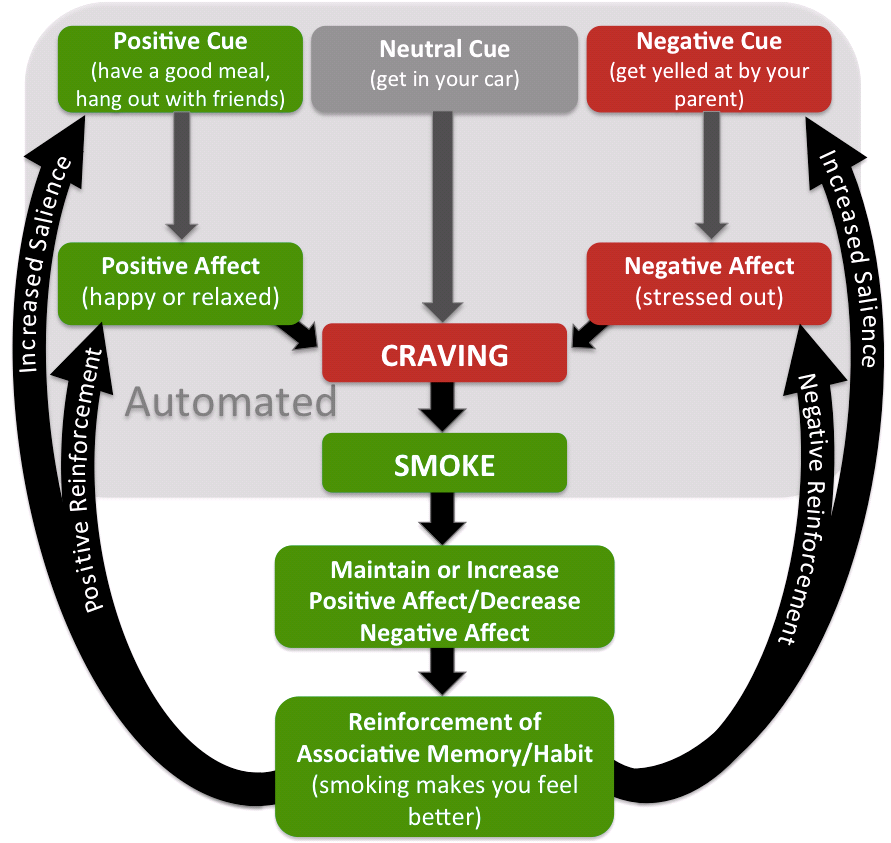 First, let’s think about why it is so tough to quit smoking. An “addictive loop” is formed between the effect of nicotine (the drug in cigarettes), and whatever is associated with smoking. This might be what we call affective states. Such as feeling happy and relaxed when hanging out with friends or stressed when having an argument with your parent. It might be just doing something you usually do when smoking like driving or talking on the phone (called triggers). When paired repeatedly, these affective states or triggers lead to cue-induced craving automatically, without the teen being aware of. Our usual strategies that teach smokers to avoid cues or divert attention from cravings may not tackle this addictive loop.
First, let’s think about why it is so tough to quit smoking. An “addictive loop” is formed between the effect of nicotine (the drug in cigarettes), and whatever is associated with smoking. This might be what we call affective states. Such as feeling happy and relaxed when hanging out with friends or stressed when having an argument with your parent. It might be just doing something you usually do when smoking like driving or talking on the phone (called triggers). When paired repeatedly, these affective states or triggers lead to cue-induced craving automatically, without the teen being aware of. Our usual strategies that teach smokers to avoid cues or divert attention from cravings may not tackle this addictive loop.
That’s where mindfulness training comes in. Evidence from studies with adult smokers shows that mindfulness training may actually target the addictive loop. This can be done by breaking the relationship between craving and smoking and resulting in greater smoking cessation. It does this by bringing that automatic smoking behavior into awareness. This allows the smoker to work mindfully with affective states and craving as they arise, rather than reacting by smoking. What is mindfulness training? It involves learning to maintain attention on your immediate experience, and maintaining an attitude of acceptance toward that experience.
studies with adult smokers shows that mindfulness training may actually target the addictive loop. This can be done by breaking the relationship between craving and smoking and resulting in greater smoking cessation. It does this by bringing that automatic smoking behavior into awareness. This allows the smoker to work mindfully with affective states and craving as they arise, rather than reacting by smoking. What is mindfulness training? It involves learning to maintain attention on your immediate experience, and maintaining an attitude of acceptance toward that experience.
The use of mobile technology may be a good way to deliver mindfulness training for smoking cessation, especially for teens. That’s because adolescent smokers don’t typically use traditional smoking cessation treatments. They also like the anonymity and confidentiality of mobile technology. Also, about 85% of 12-18 year olds have smartphones. And there are no differences in smartphone ownership between boys and girls or between teens in low-earning and high-earning households.
 So the Craving to Quit (C2Q) app was developed to help smokers self-monitor and identify their triggers/cues to smoke. The app also helps smokers learn and practice ways to become more mindful of cravings and ride them out. It’s a 21 day training program with engaging daily modules, exercises, and check-ins to notice cravings and mood. It teaches the smoker to apply mindfulness using RAIN. Recognize cravings. Accept/Allow the experience without resisting. Investigate what is happening in their body during the craving. And Note the body sensations from moment to moment while they ride out the craving.
So the Craving to Quit (C2Q) app was developed to help smokers self-monitor and identify their triggers/cues to smoke. The app also helps smokers learn and practice ways to become more mindful of cravings and ride them out. It’s a 21 day training program with engaging daily modules, exercises, and check-ins to notice cravings and mood. It teaches the smoker to apply mindfulness using RAIN. Recognize cravings. Accept/Allow the experience without resisting. Investigate what is happening in their body during the craving. And Note the body sensations from moment to moment while they ride out the craving.
Given how well it worked with adult smokers, we adapted the adult version of Craving to Quit for teens (C2Q-Teen). Teens told us they really liked the app, particularly the check-ins, videos and reminders. They noted it was difficult to use the app consistently. They also noted that they needed to be accountable to someone in order to complete the app sessions. Given school nurses are the primary health care provider in the school, we built in brief weekly meetings with them. The nurse is to provide the teens with support and accountability while using the Craving to Quit-Teen app. We then tested feasibility of the app in 3 high schools with teens who smoked and were interested in quitting. The test included teens who smoked about 5 cigarettes per day in the past 7 days and had a smartphone.
 What happened? Well, 75% of the teens used the app, with about half completing all 22 modules. The mean number of modules completed was 14 out of 22, or 65% of the modules. That’s really good. After 6 months, about 14% of the teens were no longer smoking, validated by cotinine assessment (an objective marker of smoking). Most interestingly, the more the teen used the app, the greater the cotinine validated abstinence. And for those teens who were unable to quit? The more they used the app, the greater the reduction in the number of cigarettes they smoked. This suggests there is promise in using the Craving to Quit app with teen smokers. The key here being to help teens stick with the program and use the app to get the best outcomes
What happened? Well, 75% of the teens used the app, with about half completing all 22 modules. The mean number of modules completed was 14 out of 22, or 65% of the modules. That’s really good. After 6 months, about 14% of the teens were no longer smoking, validated by cotinine assessment (an objective marker of smoking). Most interestingly, the more the teen used the app, the greater the cotinine validated abstinence. And for those teens who were unable to quit? The more they used the app, the greater the reduction in the number of cigarettes they smoked. This suggests there is promise in using the Craving to Quit app with teen smokers. The key here being to help teens stick with the program and use the app to get the best outcomes